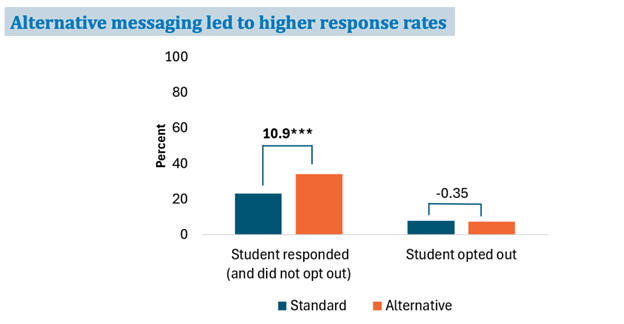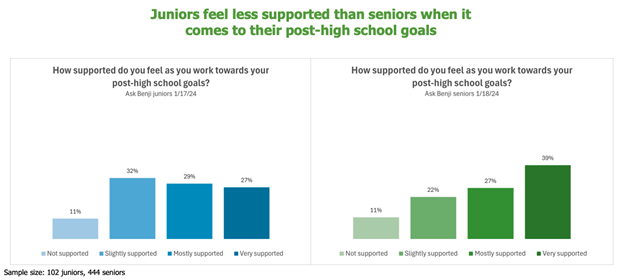Bridging the Distance: How AI Helps Educators Connect with Students in Washington and Arizona
Published by: WCET | 10/24/2024
Tags: Artificial Intelligence, Distance Education, Student Success
Published by: WCET | 10/24/2024
Tags: Artificial Intelligence, Distance Education, Student Success
Digital Learning technologies can foster meaningful engagement even at a distance. New approaches in Washington and Arizona show how AI can help support distance education students. These tools help schools provide personalized, timely communication. AI-driven initiatives like Washington’s OTTERS project and Arizona’s Ask Benji make students feel more connected and supported. We are happy to welcome Jason Fife from Mainstay to discuss these initiatives. Thank you to Jason and these project teams for sharing your work!
Enjoy the read and enjoy your day,
Lindsey Downs, WCET
One of the greatest challenges for educators and institutions committed to distance learning is fostering meaningful engagement with students who may never set foot on campus. The difficulty of reaching learners across distances—both physical and personal—has been a long-standing issue in higher education. For institutions focused on distance education, establishing meaningful engagement can feel like an uphill battle. Students often struggle to feel connected and supported when their interactions with institutions are largely remote. The stakes are even higher for students navigating complex processes like financial aid and college enrollment, especially those from underrepresented backgrounds who may lack the support systems of their peers.
However, recent initiatives in Washington and Arizona demonstrate how AI, often viewed as a tool for efficiency, can actually be a bridge to deeper, more personal connections with students.
At the forefront of tackling this issue is the Washington Student Achievement Council (WSAC), in collaboration with MDRC and Mainstay, through the OTTERS project (Optimizing Texting Technology through Engagement Research with Students). The initiative, funded by the Capital One Foundation, seeks to leverage AI-powered messaging to support students during critical stages of their educational journey. The goal of this project is to close information gaps that prevent Washington students from successfully enrolling in college or completing their financial aid applications through the delivery of personalized, timely messages.
In Washington, the OTTERS project focused on identifying barriers that students face when completing key tasks like FAFSA submissions. The overall FAFSA completion results were telling: only 39% of college-bound students submitted their FAFSA forms without errors, and only 41% successfully transitioned to postsecondary education. The data also revealed significant equity gaps—students from lower-income families and first-generation college applicants were particularly affected.
To address these challenges, the WSAC team implemented OtterBot, an AI-powered platform designed to communicate with students at scale. The messages, refined through A/B testing and insights from behavioral science, were personalized and contextually relevant. These changes paid off—students from rural areas and those with lower GPAs engaged more frequently, and opt-out rates dropped. The ability to tailor communication to each student’s needs showed how AI can be a powerful tool for supporting students remotely, particularly those who are hardest to reach.

Arizona students faced similar challenges when enrolling in post-secondary education or completing FAFSA. Initially, their “Ask Benji” initiative targeted high school seniors, helping them complete FAFSA forms and navigate the college application process. However, the team realized that engaging students earlier—during their junior year—could provide more consistent support throughout their high school journey. Juniors, they found, felt less supported in their planning for post-high school life compared to seniors.
To close this gap, the Ask Benji team expanded its AI-powered communication to juniors, sending personalized, bi-weekly messages focused on FAFSA completion and college preparation. Early results have been encouraging—students feel more connected and supported, even though the interaction happens entirely through their phones. This expansion into earlier intervention represents a significant step forward in helping students prepare for the future, even when they aren’t physically present on campus.

What makes the AI-driven efforts in Washington and Arizona stand out is the intentional focus on enhancing, rather than replacing, human interaction. Both AI systems, powered by Mainstay’s platform, handle routine communication, such as sending reminders and answering frequently asked questions. This allows educators to spend more time on high-touch, personalized interventions that require human expertise.
By scaling outreach in a way that feels personal, these tools ensure that students don’t fall through the cracks—especially in distance learning environments where in-person check-ins are less frequent. The AI enables institutions to listen and respond to students at scale, making every interaction feel timely and relevant, no matter where the student is.
The OTTERS and Ask Benji projects offer a practical model for how distance education institutions can use AI to bridge the engagement gap.

With the upcoming release of the OTTERS Toolkit—complete with messaging prototypes, survey instruments, and process mapping resources—other institutions will soon have the opportunity to adopt these strategies and tailor them to their own student populations.
As distance education continues to grow, these and other AI tools offer a way forward. They show that, when used thoughtfully, technology can foster the kinds of personal, human-centered connections that are crucial to student success. The work being done in Washington and Arizona is paving the way for a future where AI helps institutions not only scale their outreach but also deepen their relationships with students, even across great distances.
This article was written by Jason Fife.
Director, Marketing, Mainstay